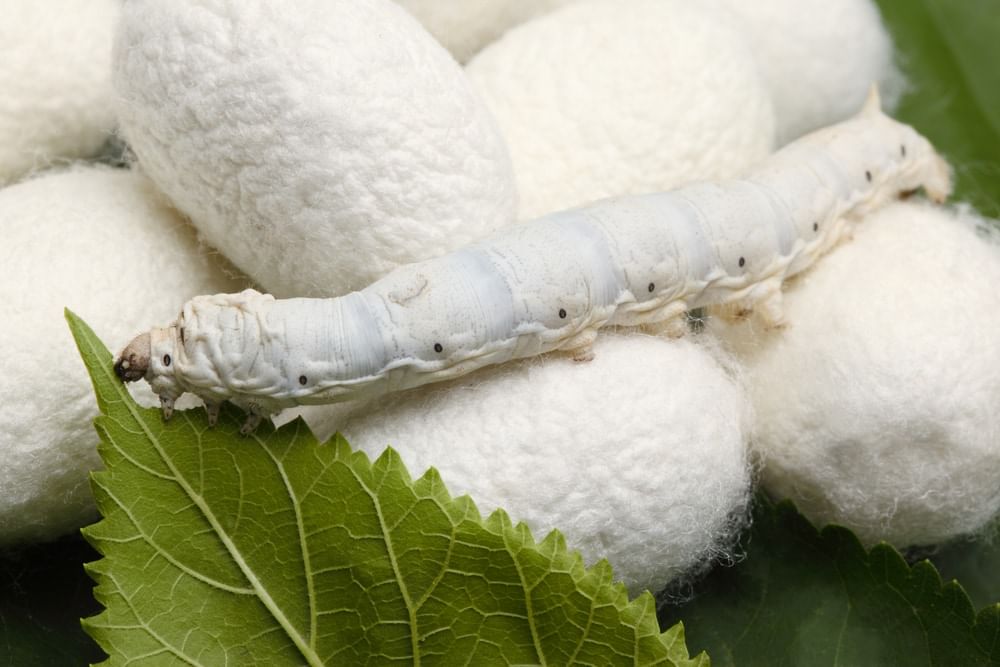Class 7 Science Question Answers - Fibre to Fabric
Very Short Q & A :
Q1: Wool is obtained from __________________ of sheep or yak.
Ans : Fleece
Q2: Silk fibres are obtained from cocoons of _________________.
Ans : Silk moth
 Cocoons of silkworm
Cocoons of silkworm
Q3: Name some animals which provide us with wool.
Ans : Sheep, goat yak etc.
Q4: Yak wool is common in
a. Tibet
b. Ladakh
c. Both a and b
d. None of these.
Ans : Both a and b.
Q5: Name the place where Angora goats are found in plenty.
Ans : Hilly region like Jammu and Kashmir.
Q6: Name some Indian breed of sheep.
Ans : Lohi, Rampur, bushair, Nali, Bakharwal , Marwari and Patanwadi
Q7: Kashmiri goat's under fur is woven to form fine shawls called __________________.
Ans : Pashmina shawls
Q8: The fur on the body of camel is also used as wool .True/False.
Ans : True
Q9: Which parts of the black sheep have wool?
Ans : The hairy skin called fleece have wool in black sheep
Q10: Name the protein which is the chief component of wool fibres.
Ans : Keratin is the chief component of wool fibres
Q11: Name the process involved in getting fibres form the sheep.
Ans : The sheep's hair are Sheared off from its body, scoured, sorted, dried, dyed, spun and woven to yield wool.
Q12: Define sericulture.
Ans : The rearing breeding and management of silkworms for obtaining silk is called sericulture.
Q13: Caterpillars should be collected from bare hand or not?
Ans : No
Q14: Name the country which is the largest producer of silk.
Ans : China
Q15: Silk is a good conductor of heat or poor conductor of heat?
Ans : Poor
Q16: What is yarn?
Ans : Yarn is a long continuous thread that is made up of fibre.
Q17: ______________is a dried perspiration found in raw wool.
Ans : Suint
Q18: What is ginning?
Ans : The process of removing seed from cotton called ginning.
Q19: Spinning is a process of making fibers. True/False.
Ans : False
Q20: Weaving yarn makes a piece of fabric. True/False
Ans : True
Q21: Polyester is a natural fibre. True/False.
Ans : False
Q22: Name a strongest variety of silk.
Ans : Mooga
Q23: Define weaving.
Ans : Weaving is the process of arranging two sets of yarns together to make a fabric.
Q24: Define spinning.
Ans : The process of making yarn from fibres is called spinning.
Q25: Name the most common silk moth.
Ans : Mulberry silk moth.
Q26: Name some varieties of silk.
Ans : Mulberry silk, tassar silk, eri silk, Mooga silk etc.
Q27: ______________ weaves silk threads into silk cloth.
Ans : Weaver
Q28: What do you mean by cocoon?
Ans : Caterpillar in its later stage of development completely covers itself by silk fibres and turns into pupa. This covering is known as cocoon.
Q29: Name two animals of South America that yields wool.
Ans : Llama and Alpaca.
Q30: Which of the following does not yield wool?
a. Yak
b. Camel
c. Woolly dog
d. Goat
Ans : Woolly dog
|
26 videos|32 docs|9 tests
|
FAQs on Class 7 Science Question Answers - Fibre to Fabric
| 1. What is fibre to fabric? |  |
| 2. What are natural fibres? |  |
| 3. What are synthetic fibres? |  |
| 4. What is the spinning process in fibre to fabric? |  |
| 5. How are fabrics made from yarns in the fibre to fabric process? |  |

















